Guerrilla Gravity Trail Pistol
Size Tested: 3
Geometry: (Here)
Build Overview (2019 Ride 1 Build Kit):
- Drivetrain: Sram GX Eagle
- Brakes: Sram Guide RS
- Fork: Rockshox Pike RC
- Rear Shock: Rockshox Deluxe Select
- Wheels: DT Swiss XM1501 i30
Wheels: 29′′
Travel: 120 mm rear / 130 mm front
Blister’s Measured Weight: 30.8 lbs (14 kg) without pedals
MSRP: $4,595
Reviewers:
- Noah Bodman: 5’9”, 155 lbs
- David Golay: 6′, 165 lbs
Test Locations: Whitefish, Montana; Seattle Area, Washington
Duration of Test: ~4 months
[Note: Our review has been conducted on the 2019 Trail Pistol, which returns unchanged for 2020, apart from some build changes noted in David Golay’s update.]
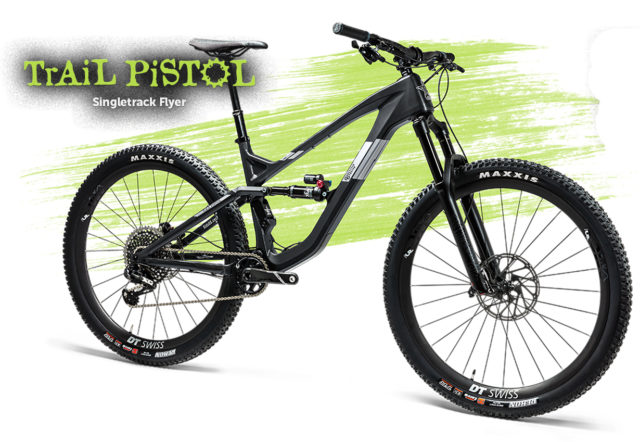
Intro
The Guerrilla Gravity Trail Pistol has been around for a few years now, situated as an “aggressive” short-travel Trail bike. For this year, the aluminum version was replaced with a new “Revved” Carbon frame, which is similar in intentions to the aluminum version, but has a whole bunch of cool new features to talk about. We got our hands on one of the first ones built, and I put together some initial impressions earlier this summer. I’ve been riding the bike all summer and have put a few hundred miles on it, so it’s now time for a more in-depth look at the bike.
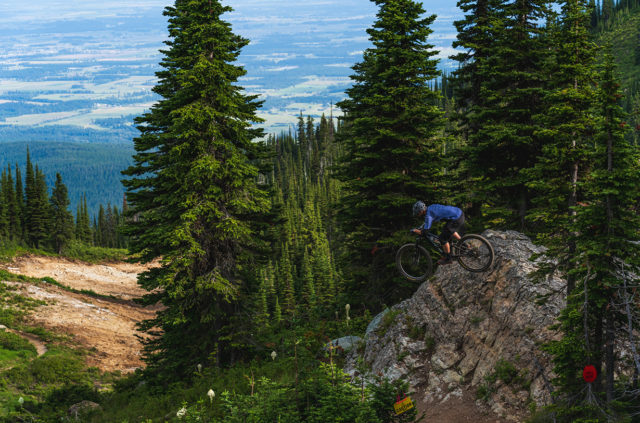
For those unfamiliar, Guerrilla Gravity is a small company based out of Denver, Colorado. They’ve gained a reputation for producing no-bullshit aluminum frames that were made in-house in their Colorado factory. That reputation, combined with the relatively reasonable pricing they’ve offered, has garnered them something of a cult following.
But Guerrilla Gravity made waves this past winter when they announced that they were switching to carbon. Now, a company making carbon frames is hardly noteworthy these days, but what really turned heads was that (1) Guerrilla Gravity is making their carbon frames in house, in Colorado; (2) the frames are actually less expensive than most of the Asian-made carbon frames on the market right now; and (3) Guerrilla Gravity is saying that their carbon frames are actually 300% more impact resistant.
For more on Guerrilla Gravity, how they do things, their switch to carbon, and why they think their carbon is actually better than most of what’s on the market, give a listen below to our Bikes & Big Ideas podcast where we talked with Guerrilla Gravity’s co-founders and director of composites engineering:
If all that doesn’t make you pause and take note, I don’t know what will. In an era where overwhelmingly similar bikes are churned out from a handful of factories in Asia, it’s rare to see a company doing something different. But is different actually better? Here’s my take:
The Ordering Process
We ordered our Trail Pistol through the normal process on Guerrilla Gravity’s website. So we put in a pre-order on February 19, and then got confirmation that the frame was ready to go on May 10. The bike showed up on our doorstep on May 30.
That timeline may look a bit long, but it was very much in line with what Guerrilla Gravity said it’d be from the outset. So in other words, they delivered the product on the timeline they said they would. This was also the first run of their carbon frames, so I expect that the timeline will be quite a bit shorter in the future.
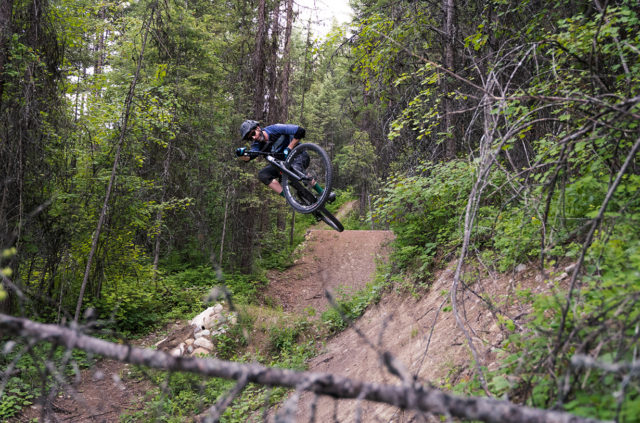
The bike arrived in two boxes — one with the wheels, and one with everything else. The bike was mostly built; all that needed to be done was bolt on the wheels, rear derailleur, handlebar, and controls. Things were more or less set up — I had to tweak the shifting a bit, and of course suspension and tire pressures needed to be set. But getting the Trail Pistol up and running is a surmountable task for anyone that’s even moderately mechanically inclined and has a set of hex wrenches.
The Frame
The Trail Pistol is built around Guerrilla Gravity’s Revved Carbon front triangle, with an aluminum rear end. While in the past they’ve been known for their stout aluminum frames, Guerrilla Gravity has actually made some pretty cool innovations with the Revved Carbon front triangles.
First and foremost, the carbon frames are built in Colorado via a process that’s tangibly different than most carbon frames. The details here are a bit vague because there are assorted patents pending and trade secrets at play, but the gist of the situation is this: Guerrilla Gravity secured a substantial grant to develop their carbon process, and they’ve developed a process that has some noteworthy changes at multiple stages of building the frames.
Building a carbon frame generally involves “laying up” hundreds of pieces of the carbon fiber cloth that comprise the frame, which are then placed in a mold. This process is normally done by hand, and it takes a really long time. Part of the innovation in Guerrilla Gravity’s Revved process is that it uses an automated machine to do most of the lay-up work. This cuts the time to build a frame by a substantial amount, and it also increases accuracy in the layup. The idea of a CNC robot laying up carbon fiber isn’t a new one — the aerospace and automotive industries have been doing it for a while. But those processes generally built flatter shapes — Guerrilla Gravity had to come up with a new process to use automation to construct the hollow tubes of a bike frame.
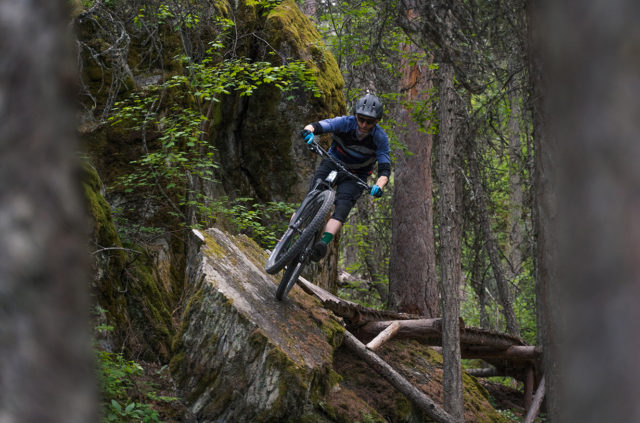
While the actual carbon used in the Revved carbon frames is similar to what you might find on other carbon frames, the resin that’s used to bind those sheets of carbon together is different. Again, the details here are secret, but changes in the resin appear to be largely responsible for the increased durability that Guerrilla Gravity is claiming. The resin also cures at a higher temperature and more quickly than traditional carbon resins, so again, the production time for a frame is reduced.
All of that innovation is pretty cool from an armchair engineer standpoint, but for the end user, the real noteworthy aspect of the whole thing is that, by building in efficiencies throughout the process, Guerrilla Gravity is able to keep the cost down. With frames going for $2,195 (without a shock), the Revved Carbon frames are actually some of the least expensive carbon frames on the market.
Carbon processes aside, there’s a bunch of other noteworthy features of the Guerrilla Gravity frames that are probably more relevant to the rider.
Modular Platform
Guerrilla Gravity offers four frames that use their Revved Carbon process:
- The Trail Pistol that I rode (120 mm rear travel, 29” wheels)
- The Smash (145 mm rear travel, 29” wheels)
- The Shred Dogg (130 — 140 mm rear travel, 27.5” or 27.5+ wheels)
- The Mega Trail (155 — 165 mm rear travel, 27.5” wheels).
All of those frames use the exact same front triangle and chainstay. And any of those frames can be converted into any of the other frames by changing the seatstay kit (which Guerrilla Gravity sells for $445), and depending on the bike, swapping the rear shock. Of course, you’ll likely need to swap the fork, or at least change its travel, and you’d need new wheels if you’re converting from 29” to 27.5” (or vice versa). But the front triangle and chainstays are the same across those four models.
While I’ve seen other companies share portions of bikes across their models before, I can’t think of another company that has built their entire full-suspension lineup around a modular platform. While this undoubtedly makes sense from a cost-savings perspective, as the end user, I think it’s a really good idea. It’s also noteworthy that I don’t see there to be much of a sacrifice in terms of geometry across any of the models. The only real downside I see is that the frames are built around the demands of the burlier models — the Smash and the Megatrail. So for a shorter-travel model like the Trail Pistol, the frame is burlier than some people might need or want out of a shorter-travel package.
GeoAdjust Headset
I’ll get into the actual sizing and geometry below, but it’s noteworthy that the Revved frames only come in four sizes. But just as noteworthy is the fact that they all have a “GeoAdjust Headset,” which is basically an aluminum insert in the headtube that can be flipped around to change the reach by about 10 mm. So, effectively, this makes each frame size act as two frame sizes.
Functionally, the GeoAdjust Headset is pretty simple. It’s a square aluminum block with a small rubber seal that fits snugly into the carbon frame. The actual headset that’s included is a standard FSA; there’s nothing proprietary in terms of the bearings, so replacement (when needed) is easy.
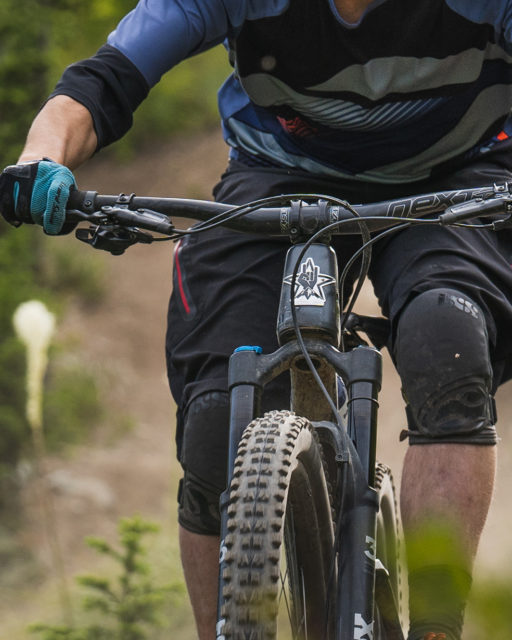
The big question for me with the GeoAdjust headset was: how long will it take to start creaking? The answer: I don’t know. ~500 miles in, plenty of mud and wetness, and zero maintenance to the headtube region has yielded zero noise.
The downsides? Well, especially in “short” mode, the headtube looks pretty blocky and massive. It gets a lot of comments. Also, in short mode, I can’t run the stem fully slammed to the head tube, otherwise the faceplate bolts hit the front edge of the headtube. Running a 5mm spacer under the stem takes care of this. So, no, the downsides aren’t very significant.
The Suspension Design
The Trail Pistol (along with the rest of Guerrilla Gravity’s full-suspension bikes) are built around a pretty straightforward horst-link design. This means, at least in terms of the pivot locations, they’re roughly similar to the FSR link bikes from Specialized and quite a few other brands. This suspension design has been around for decades, and it’s well proven.
The Guerrilla Gravity variation on the design is a bit different than the most common iterations of a horst-link suspension. Most notably, the shock is driven off of the seat stay, whereas many other horst-link bikes tend to be driven via a swing link of some sort. The Trail Pistol still has a swing link that modifies how the shock is compressed (and does a lot to laterally stiffen up the rear end), but the shock itself mounts to the ends of the seatstay.
At that shock mount, the Trail Pistol has a two-way flip chip that can be set to “Plush Mode” or “Crush Mode.” While lots of bikes have flip chips for adjusting the bike’s geometry, the Trail Pistol’s chip is only to adjust the bike’s leverage ratio — Plush Mode is a bit softer off the top to help out with traction; Crush Mode is a bit more supportive through the mid stroke to make the bike better at pumping.
Details
There are a bunch of details incorporated into the Trail Pistol frame that make it pretty clear that the frame was designed by someone who actually rides a bike (and works on it). First, the frame fits a water bottle in a convenient location (under the top tube, above the shock). My size Three fits a full-size bottle, albeit somewhat snugly.
Second, there’s a little mounting bracket that makes it easy to strap a tube, a CO2 cartridge, and a multitool to the frame. You can buy a mounting strap directly from Guerrilla Gravity that works well, or pretty much any velcro / ski strap will work fine.
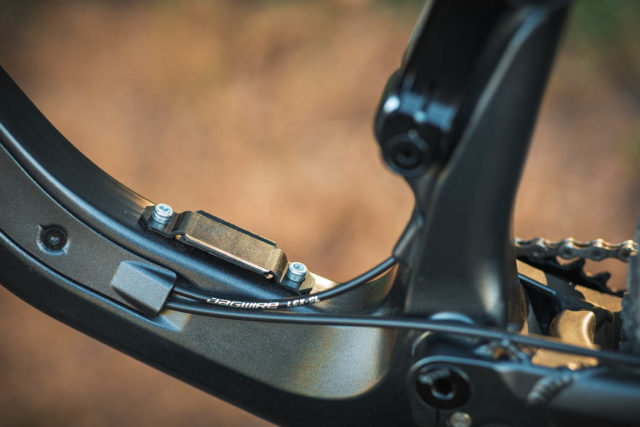
Third, the cables are routed externally in a channel that’s molded into the frame, but there’s a bolt-on cover that keeps everything looking tidy. This is kind of the best of both worlds — you get the clean look of an internally routed frame, but the maintenance ease of external cables and hoses. The only downsides here are (1) it can be slightly fussy to get all of the cables to sit nicely in the channel while you bolt the cover back on, and (2) since the channel is on the left side of the frame, the dropper post cable has to make a tighter curve out of the lever.
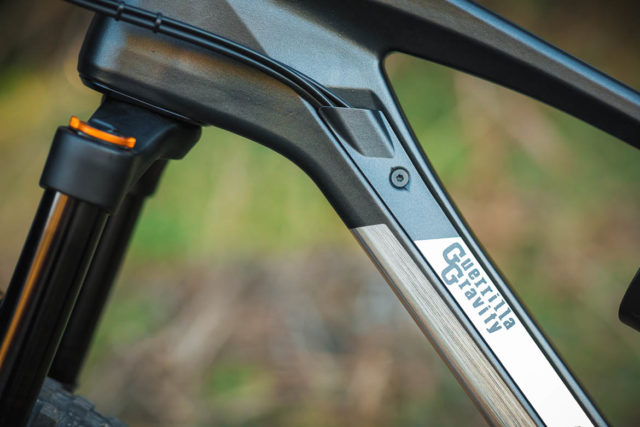
Fourth, threaded bottom bracket. Less creaks, easier maintenance. Enough said.
Fifth, the rear axle threads into a replaceable nut. If you bungle the threads, replacement is cheaper and easier.
Other notes: There are ISCG05 tabs for mounting a chainguide / bashguard; pretty standard these days, and fairly necessary on any good frame, in my opinion. Bearings in the pivots are Enduro Max in standard sizes. These are pretty much the go-to in most quality full-suspension bikes these days; they hold up well, and they’re easy to find replacements for when the time comes. As a whole, there’s nothing proprietary or weird about the frame — every part and size, from the derailleur hanger to the shock mount, is pretty standard and easily replaceable if it breaks.
Geometry and Sizing
Like a number of other brands, Guerrilla Gravity has gone away from traditional Small / Medium / Large sizing, and now just calls their sizes 1, 2, 3, and 4. And, as noted above, with their GeoAdjust headset, each of those sizes has a short and long orientation, with the difference being roughly 10 mm in extra reach in the long position.
The theme throughout the size run is that the bikes are looong. The smallest size — a size 1 — has a reach measurement of 438 mm with the GeoAdjust headset in the “short” position. To put that into perspective, a 2016 Specialized Stumpjumper had a 435 mm reach. In a size Large. So the smallest Trail Pistol has a longer reach than a Large Stumpjumper from three years ago.
So there are a few takeaways from that. Yes, the most obvious one is that bike geometry has changed a whole lot in the last few years. And while the Trail Pistol’s geometry is at the pointy end of the progressive stick, it’s really not that unusual in this day and age.
But more importantly, while the Trail Pistol is undeniably long in some respects, that doesn’t tell the whole story about how the bike fits. And the reason for that is the steep seat tube angle — 78.2° effective, 74° actual. Even by modern, progressive geometry standards, that’s pretty steep. And the result of that is a relatively short top tube length — on my size 3, the effective top tube is 615 mm. That’s somewhere between normal and short for a size Large bike, and it’s also noteworthy that, because the seat angle is so steep, the top tube doesn’t feel way longer when the seat is put up to proper pedaling height for us long-legged folks.
The end result of all of that is a bike that feels pretty “normal” for seated pedaling. While a glance at the numbers makes the bike look long, the saddle-to-handlebar length on my bike is actually pretty short compared to other Large bikes. That length, on my size 3, is closer to what would traditionally have been a Medium.
But once you stand up, that reach length is (very) noticeable — this is, in fact, a long bike. And that long reach also produces a long wheelbase, which is also noticeable. Below I’ll get into how that translates to the ride, but in terms of fit, the takeaway here is that the bike feels short on the way up (while seated) and long on the way down (while standing).
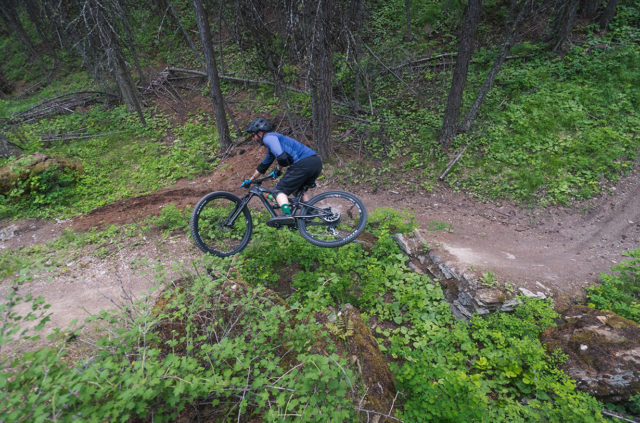
As a side note, Guerrilla Gravity has a cool little feature on their website where you enter your height and riding style (“All Around” or “Full Throttle”), and it’ll recommend a frame size, headset orientation, and stem length. I’m 5’9” and I’m right on the edge of the Size 2 and Size 3 — if I pick “All Around,” it puts me on a size 2; if I pick “Full Throttle,” it puts me on a Size 3.
I went with a Size 3, which I run in the short setting, with a short 32 mm stem. If I were going to do it again, I’d go with a Size 2, probably set in the long position. There are a few reasons for this, which I’ll get into more below. But purely in terms of fit and sizing, I could have ended up with a pretty similar cockpit feel on a Size 2 with a longer stem, and I’d have more wiggle room to dial in fit with stem length. I also think the bike looks a little weird in the short GeoAdjust setting, which is a terrible reason to go to a shorter frame, but here I am, writing this on the internet where it will live forever.
Fitment issues aside, the numbers on the Trail Pistol are fairly progressive for a 120mm-travel bike, but they’re not unheard of. A 65.9° head tube angle (with the stock 130 mm fork) is slack, but not crazy slack. 426 mm chainstays are decidedly short for a 29er, but despite those short stays and not-crazy-slack head angle, the wheelbase is a rangy 1219 mm on my Size 3. Most of that length comes from that long front triangle.
And if any of that discussion was a bit confusing, check out our Geometry 101 and 102 articles.
The Build
Guerrilla Gravity offers the Trail Pistol as a frame only ($2,195 not including a shock), or as a complete bike with 3 different build kits; the top-of-the-line Race ($5,895), the Ride 1 ($4,595) that I rode, and the fairly affordable Ride 2 ($3,695).
Guerrilla Gravity also allows for modifications to any of their build kits — you can upgrade almost any part. Depending on the swap, there might be an upcharge or (occasionally), savings. I’ve seen a couple other brands doing this, and this is really, really fantastic. There are certain parts that I really like on my bikes, and there are some that I swap out immediately. Guerrilla Gravity makes the process of getting the exact build I want a lot easier, and a lot more affordable.
That said, in the interest of this review, I didn’t swap much on the Ride 1 build I rode. The only changes I made were the stem (to swap to the shorter 32 mm length that they recommended), and the tires (the stock Trail Pistol comes with Maxxis Rekons front and rear, but I switched to a DHF / DHRII setup because… Rekons).
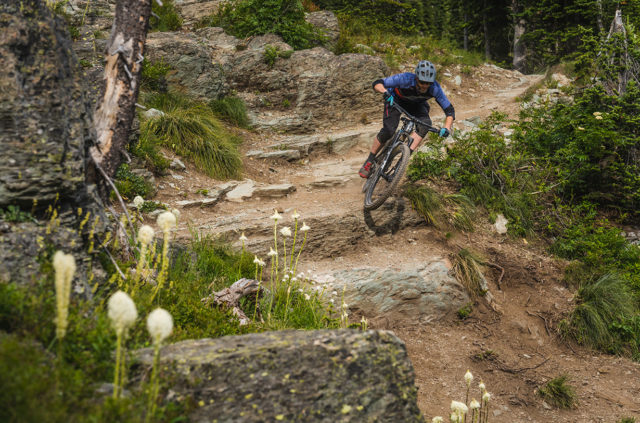
The Ride 1 kit is built around a Sram GX Eagle kit. While the higher-end Eagle Groups hold up and perform better, the GX Eagle kit has been my go-to pick for a reasonably priced yet very functional drivetrain. That may change in the near future with the recent release of Shimano’s 12-speed XT kit, but it’s too early to say.
My only complaint about the drivetrain is that Guerrilla Gravity spec’d a KMC X12 chain. The KMC chain doesn’t shift as well as a Sram chain, it doesn’t hold lube as well as a Sram chain, and it’s louder than a Sram chain. I don’t care how much cheaper that thing is — if the bike comes with a Sram cassette, derailleur, and chainring, just spec a Sram chain (and if it’s a Shimano drivetrain, spec a Shimano chain).
Braking on the Trail Pistol is handled by Sram Guide RS stoppers with 180 mm rotors. While the Guides have had their problems, I personally still prefer them to any other common brake on the market (namely, Shimano XT’s). The Guides have great modulation, they have a consistent feel, and the bleeding system is the best in the industry. I also like that Guerrilla Gravity spec’d the RS version, which has noticeably better modulation than the lower-end R’s.
Suspension on the Ride 1 Trail Pistol is handled by Rockshox, with a Pike RC (130 mm travel) in the front and a Deluxe Select+ rear shock. Both of those units are entirely adequate performers, although it felt like they could get a bit overwhelmed on longer, faster descents. After about a month on the bike, I ended up swapping out the 130 mm Pike RC for a 140 mm Fox 36 — partly because the 36 handles hard riding a bit better, and partly because I wanted to bump up the travel in front. I also spent a bit of time with a coil Fox DHX2 on the rear — more on how that affects the ride below. While the DHX2 isn’t available as an option from Guerrilla Gravity, it’s probably roughly comparable to the MRP Hazzard, which is available for a $310 upcharge.
Wheels in the Ride 1 package are the entirely serviceable DT Swiss XM 1501 i30’s. They have a 30 mm rim, and the rear hub has the upgraded 36t engagement. They’re not fancy, but they get the job done well.
I hadn’t used the SDG Tellis dropper post prior to this bike, but so far, no complaints. It does what I ask it to, it hasn’t gotten squishy or sticky, and I like the lever.
My only other gripe about the Ride 1 build is the tires. Yes, swapping from the Rekons to a DHF / DHRII combo was free and easy (I already had those tires). But the real problem is that Guerrilla Gravity doesn’t offer anything but Exo casings. Particularly for a rear tire, that just doesn’t cut it for me (or, more accurately, it gets cut. A lot). How am I supposed to go “Full Throttle” without air in my tire? Consider this a polite request to offer some Doubledown or DH casings on the customization page.
So stock build kit aside, given the option to make some upgrades to this kit, where would I put my money?
Hands down, the #1 upgrade would be swapping the fork to a Fox 36 Performance Elite with 140 mm travel. First, the Grip 2 damper and 36 chassis blow the Pike RC out of the water. Second, I think the bike rides and handles better with a 140 mm fork (more on that below). And lastly, if you decide to take advantage of the modular frame and turn the Trail Pistol into a Smash at some point in the future, the Fox 36 is far better suited to long-travel duties than the Pike, and you can extend the 36’s travel simply by swapping the air shaft. I haven’t spent as much time on it, but the MRP Ribbon is also a solid option here, and it’s a good bit cheaper than the Fox. Personally, I’d pass on the Cane Creek option; the performance just doesn’t quite match the better forks in this class.
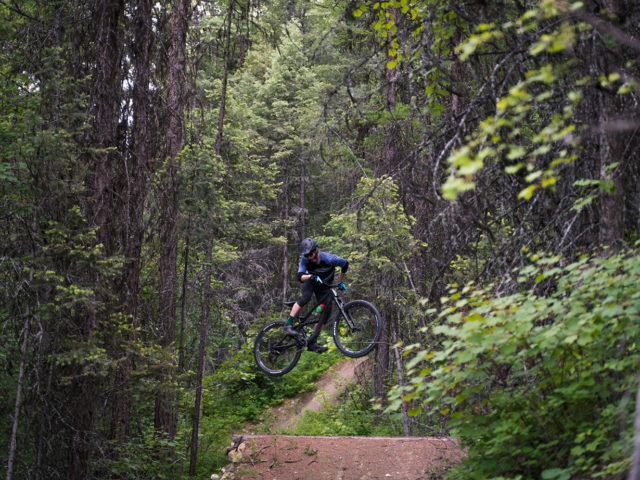
Beyond that, I’d probably add a bash guard, and I’d likely bump up to a longer-travel seatpost — even on the Size 3 frame, I’d have no problem fitting a 170+ mm post. I’d probably go for the 185 mm Bike Yoke Revive.
Lastly, I’d be pretty tempted to bump up the brakes to some Sram Code RSC’s. Those are, thus far, my favorite brakes on the market. They’d be slightly overkill on the Trail Pistol, but if I ever switched the frame over to a Smash, those brakes would be, as they say, the bee’s knees.
Also, as a side note, Guerrilla Gravity gives an estimated weight for each of their builds, and the estimated weight is updated when you customize the build. For my build, in a Size 3, the estimated weight was 28.79 lbs. The actual weight of my bike without pedals was 30.8 lbs. That’s a pretty big difference, so take the estimated weights on Guerrilla Gravity’s website with a heavy dose of skepticism.
The Ride
Ok, enough rambling about geometry numbers and tire selection. How’s this thing ride?
This is the first truly long bike that I’ve spent more than a ride or two on, so I was pretty curious how that’d go. My hope was that the Trail Pistol’s long wheelbase and slack angles would give the bike a lot of that monster truck stability that’s so fun on fast trails, but I also hoped that the short 120 mm of rear travel would keep the bike a bit more poppy and playful, and make it less unpleasant on climbs.
As it turns out, my hopes and expectations at least had some basis in reality. Yes, the bike is stable at speed. Yes, it more or less plays and climbs like a shorter-travel bike. But there’s more to it than that.
Climbing
What goes down must first go up, and on the climbs, the Trail Pistol does really well, as long as you’re comparing it to burly bikes that are more about going downhill, and that usually have more travel.
Now, using that sentence is a little bit weird for a bike that only has 120 mm travel in the back — usually bikes in that travel class are a bit more about going uphill efficiently and being ok-ish on the descent. Among 120 mm bikes, the Trail Pistol reverses that a bit. Which is to say, it’s a good climber, but no one’s ever going to mistake it for an XC race bike. It’s more appropriate to say “it climbs better than my 150mm-travel Trail / lite-Enduro bike” than to say “it climbs worse than my 100mm-travel XC race rig.” Both of those statements are true, but the first one is a more accurate assessment of the Trail Pistol.
The steep seat tube angle is fantastic on steep climbs. You don’t have to impale your tuckus on the nose of the saddle to get over the front of the bike, and you never feel like you’re fighting to keep the front end down. The steep seat tube, combined with a relatively short-travel frame, make this bike one of the best bikes I’ve ever ridden when it comes to getting up those impossibly steep climbs. And as I mentioned in the geometry section, while the bike is quite long, the top tube length is entirely reasonable, so I don’t feel overly stretched out on long, seated climbs.
In terms of pedaling efficiency, the Trail Pistol is alright. It doesn’t have that snappiness that you get from bikes that are really designed around pedaling, but there’s not an excessive amount of suspension movement when you’re grinding on the pedals, and the rear end firms up a bit when you lay down some power. Ultimately, compared to any longer-travel rig, the Trail Pistol is going to inherently feel snappier, purely by virtue of having less travel.
On mellower fire road climbs, I do feel like the extra-steep seat tube angle puts me a little too far forward of the bottom bracket. I don’t have a watt meter to do any kind of objective analytics on this, but it feels somewhere between “slightly less efficient” and “mildly awkward.” This is a biomechanical thing that’s going to be different for everyone, but for me, it’s there. That said, it’s not major, and at least for my local riding, the benefits on steep climbs clearly outweigh the slight oddness on mellow climbs.
On rootier, technical climbs where traction matters a lot, I’d put the Trail Pistol somewhere in the middle of the spectrum. It definitely gives up some ground on tricky roots compared to longer-travel bikes, and some shorter-travel bikes beat it as well. On the upside, it doesn’t wallow into its travel and fight you when you’re trying to ride up some greasy, stair-stepped mess of a trail, and again, that steep seat tube angle means that keeping your body in the right position while you fight your way up some roots is much, much easier. On the downside, it doesn’t iron out that stuff and maintain traction quite as well as some of the best technical climbers (I’ll get into specific comparisons below).
I should also note that the Trail Pistol isn’t a particularly light bike, which is noticeable on climbs. At 30.8 lbs (13.97 kg), it’s not entirely excessive for a burlier, descending-oriented bike (which is what it is). But compared to some of the 27-28 lb bikes in this class, it’s slightly porky on the climbs.
Descending
Yes, climbing matters. And if you’re looking at a 120mm-travel bike like the Trail Pistol, it’s a safe bet that you’re not shuttling to the top most of the time. But really, this bike is built for the descent. Despite its short travel, its long wheelbase and (relatively) slack headtube angle make it clear that this thing has stability at speed as a priority.
And indeed, it’s stable. Point it in the right direction and let it do its thing — it’s pretty happy going far faster than a short-travel trail bike probably should while heading down rough descents. While the Trail Pistol isn’t all that slack compared to some longer-travel rigs these days, it’s certainly slack for a 120mm-travel bike. And bumping the fork up to 140 mm (which I did, and recommend) slackens things out a little more and adds a little bit of extra forgiveness in the front, both of which make the bike even more inclined to be happy while going straight and fast.
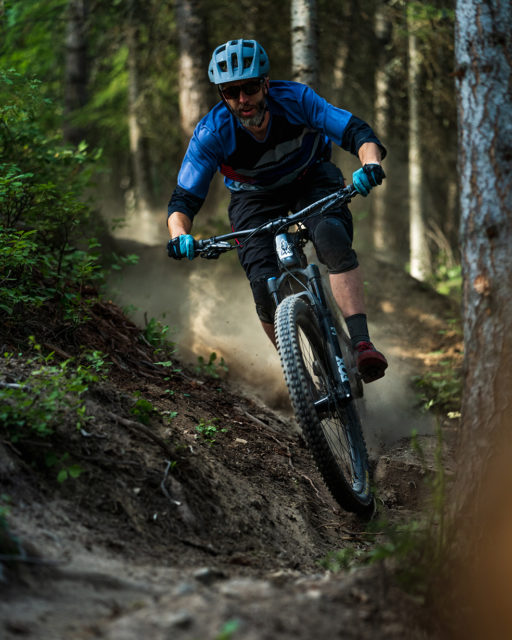
But the interesting thing about the Trail Pistol is that most of its high-speed prowess comes from the geometry. The suspension, particularly in the rear, is fairly taught — there’s not a ton of forgiveness there. At slower speeds (like on climbs), the rear end does pretty well — it’s supportive but still supple enough to maintain pretty good traction when needed. And on big impacts, it does impressively well — it feels quite progressive, so I never got a harsh clunk out of the rear end, even on super hard landings.
But for those middle-sized bumps that are probably the most common obstacle for the suspension to deal with, the Trail Pistol doesn’t iron them out as well as some other bikes (including some other bikes with comparable travel). On some rougher trails that are defined by repeated medium-sized hits (for example, a trail littered with average-sized roots), the Trail Pistol’s back end doesn’t feel like it’s doing everything it could to smooth things out, even given its relatively short travel. The result of that is a back end that bounces around a bit more and can be a bit more of a handful to keep planted through a choppy corner.
The flipside of that is that the rear end feels quite supportive. Pumping and popping on the Trail Pistol produces real results; pump through a dip and you don’t just feel like you’re mushing into the suspension — you can feel the bike accelerate forward. Pop off a small, ill-defined lip and you can make the bike go higher and farther than you expected. The Trail Pistol ascribes to the logic that the smoothest way through a rock garden is to air over it.
The more attentive readers here are asking: are you talking about the bike in “Plush” mode or “Crush” mode? Well, both. There is a difference; Plush mode is a bit more supple, and gets into its mid stroke a bit easier. Crush mode is a bit more supportive throughout. But those changes are two sides of the same coin, and compared to some other bikes in this class, the Trail Pistol is pretty clearly on the “more supportive / less supple” end of the spectrum, regardless of the shock setting.
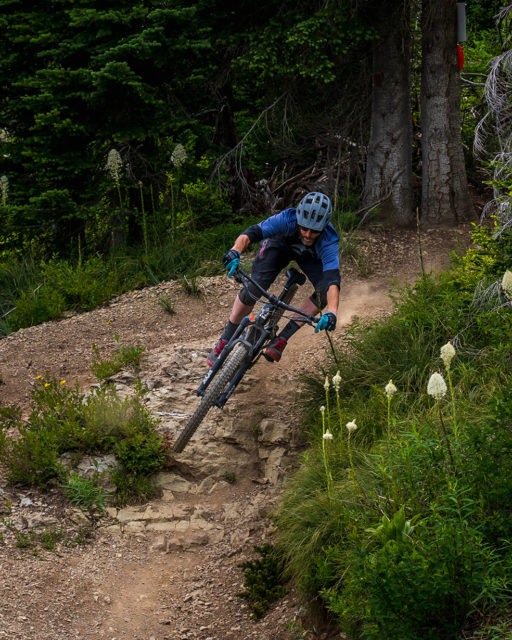
As I noted above, I swapped the stock RockShox Deluxe rear shock for a Fox DHX2 coil shock. The stock Deluxe is a fine shock, but it’s a mid-tier air shock that’s designed with lighter Trail bikes in mind, whereas the DHX2 is a high-end shock aimed at Enduro and DH bikes. So did the DHX2 transform the rear end of the Trail Pistol? Not as much as I was hoping.
The DHX2 certainly made things a bit plusher, and the bike handled mid-sized hits a bit more gracefully (while still not getting overwhelmed on big hits, I should note). But even with the coil shock, the Trail Pistol still struggles to iron out the trail as well as some other bikes in this class. It feels like the suspension is almost too progressive — the Trail Pistol handles huge hits really well, but the side effect of that is that the suspension gets fairly stiff, fairly quickly, which means it struggles to get deeper into its travel for the medium-sized hits that are by far the most common obstacle that it needs to absorb.
But another factor to consider here is the fork. A Fox 36, or a Ribbon, or a Pike, is the same regardless of what bike it’s attached to. And the Trail Pistol’s stretched-out front end means that the rider’s weight bias is naturally pretty far forward. More weight on the front means that the fork’s performance matters a bit more — if the fork is dialed and it’s tracking perfectly, then you can get away with quite a bit on the Trail Pistol, even if the back end is bouncing around a bit. Don’t take this as a defense of a less-supple rear end, but I think some riders who prioritize the extra support you get out of the Trail Pistol’s back end will be pretty happy with the suspension as long they have a dialed fork up front. And this is one more reason why I swapped to a 140 mm Fox 36 on the front, and why I think that’s a very worthwhile upgrade on Guerrilla Gravity’s customization page.
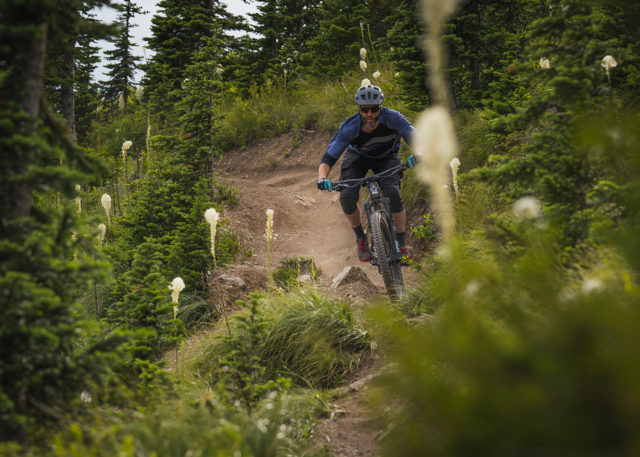
So let’s talk about turning. The Trail Pistol is a long bike, so logically, it’s going to be more of a handful in corners. As it turns out, that statement isn’t as true as I would have assumed.
Yes, when I first got on the Trail Pistol and threaded it through some bermed-up, tight, slalom-y sort of corners, I felt… less than graceful. I was on the bike and purportedly riding it, but really I was just getting yanked around in what I would describe as a vaguely controlled clusterf*ck of hackery. I survived, but it wasn’t pretty.
And it took me about a week to come to terms with what I had to do to ride this bike correctly. My conclusion: do less. Don’t fight it. Trust that the geometry puts you in the right place, and let it do its thing.
Every other bike I’ve owned has been shorter in the reach dimension, and usually in most of the other dimensions as well. And what that meant was, to keep weight on the front tire (and thereby generate traction), I had trained myself to stay forward on the bike at all times. Get over the front to push through a corner. Get over the front to attack through technical sections. Get over the front to push the front wheel through holes. Sure, different bikes with different geometries required adjustments to that, but it was all variations on the same theme.
On the Trail Pistol, I don’t have to get over the front. Or, more accurately, my neutral position on the bike already is over the front. I don’t have to make a conscious effort to keep my weight forward — I can just relax in my neutral position and let the bike go about its business. It took me a bit to learn to trust the bike; the positioning felt foreign to me.
But after a week on the bike I’d come to terms with it. And it made sense. And to a large extent, it’s easier; I can just sort of relax and trust that the bike’s geometry puts me where I need to be — weight forward and attacking.
Going back to those slalom-y, fairly tight corners? The Trail Pistol does very well as long as I don’t fight it. I’d actually say I can arc through those corners faster and with less effort than I can on some decidedly shorter bikes that seem like they should be better in that sort of situation. But as it turns out, where my weight is on the bike matters a lot. A wheelbase that’s a couple inches longer doesn’t actually matter that much in the context of a 20-foot-long berm. And since the Trail Pistol naturally puts my weight where it should be, it corners quite well, as long as I trust it.
What that rider-forward weight distribution means, however, is that I’m attacking all. the. time. The Trail Pistol doesn’t take kindly to relaxed riding. Whether you like it or not, your weight is forward and you’re driving through corners, smashing through rocks, and riding the bike like it wants (needs?) to be ridden. Your weight is on your hands, pushing down on the bars, and in turn, pushing that front wheel through every turn and obstacle on the trail.
And as a bike that’s definitely at the supportive and poppy end of the spectrum, I find myself slightly conflicted about how to ride this bike. On one hand, I want to use that supportive suspension to pop off of every feature and pump through rollers. On the other hand, the length of the bike really lends itself to going fast, preferably in a straight line. It’s true that, if I stay neutral on the bike, it actually corners really well (despite its length). But that doesn’t get around the fact that the bike prefers to straighten out corners and hold speed, rather than meander and play.
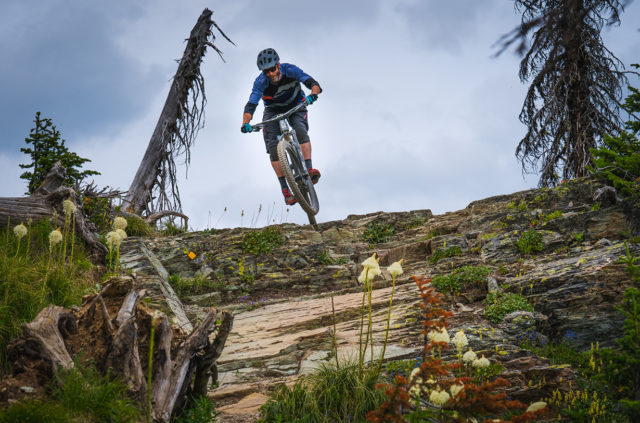
As I said at the outset, I was hoping that the Trail Pistol would find a magical balance where it felt snappy and playful due to its relatively short travel, but still could monster-truck through rough stuff due to its length. It turns out that the scales are tipped a bit more towards straight-line monster trucking, mostly due to the stretched-out geometry. So ultimately the conclusion I came to is that, while I’m quite comfortable with the length and I like how it rides, for this particular bike with the amount of suspension (120 mm) it has and the nature of that suspension (more supportive, and not overly forgiving), I’d be happier on a smaller frame that’s easier to throw around and more fun to ride at a less than pinned pace. If this was a bike with 20-30 mm more travel and I was looking for an Enduro race bike, my conclusion would be different, but that’s not what the Trail Pistol is.
To put it another way, the suspension is better for jumping and playing than for straight-line plowing. So pairing that suspension with a long, aggressive geometry that’s really good at straight-line plowing creates a bit of a conflict. So rather than a “best of both worlds” result, it ends up with more of a “sort of ok at everything” result. My take on the best way to reconcile this is to go with a shorter frame, embrace the pumpy, jumpy nature of the suspension, and worry a bit less about trying to go mach-ridiculous through rough stuff on a short-travel bike.
Durability
Thus far, I have nothing noteworthy to report. Early on, I was getting a bit of a mystery noise from the rear end of the bike that seemed to be coming from somewhere in the linkage. I took everything apart, smeared some grease on the bolts, and put everything back together. Problem solved.
Beyond that, I’ve done approximately nothing. There are a few small dents in the rims, which is pretty par for the course. I’ve had to re-tighten the rear derailleur a couple times because those Eagle derailleurs like to rattle loose. Everything I’ve done has been entirely minor, and easily within the realm of the maintenance I’d need to do on any bike I ride.
The one very minor gripe I have is that the chainstay protector is deteriorating from chain slap. It seems like the foam they use is pretty soft, and it’ll likely need replacing at some point in the near-ish future.
Beyond the chainstay-protector issue, I don’t see any impending disasters. The shock hardware is solid and well made. The same goes for the GeoAdjust headset pieces. And while I haven’t taken a sledgehammer to the frame to test Guerrilla Gravity’s claims regarding impact resistance, it’s pretty easily shrugged off a bunch of rock hits on the downtube.
All in all, Guerrilla Gravity built a reputation on burly, durable bikes. My time on the Revved Carbon Trail Pistol hasn’t done anything to change that reputation.
Comparisons
There are a bunch of ~120mm-travel bikes that are nominally comparable to the Trail Pistol. E.g., the Ibis Ripley, the Specialized Stumpjumper ST, the Devinci Django, and the Pivot Trail 429. All of those are great bikes for the right person, on the right trail. Compared to the Trail Pistol, all of them are a bit snappier up the climbs, a bit worse on the descents, and are a bit happier being ridden at a moderate, entirely reasonable pace.
Yes, the Ripley and Django have both been revised recently, but based on my time on the old versions and some moderate speculation, I’m sticking with my above statement. Of the comparable bikes that I have ridden, two stand out as being appropriate comparisons to the Trail Pistol.
Transition Smuggler
The Smuggler is a strong contender, and it’s a bike that I’ve gotten along with and recommended quite a bit over the years. I had the opportunity to ride the Smuggler back-to-back with the Trail Pistol on some great rooty, rocky trails in British Columbia, and the differences are pretty apparent. Geometry and sizing wise, the Trail Pistol is a bit more than the Smuggler in pretty much every way. For a given size, the Trail Pistol has a bit longer reach, a bit longer wheelbase, a bit slacker head angle, and a bit steeper seat tube. That said, the Smuggler is definitely still in the same progressive “long and slack with a steep seat tube” vein of bikes. Switching from the size 3 Trail Pistol to a Large Smuggler felt pretty natural.
I didn’t do a ton of climbing on the Smuggler, but it generally felt similar to the Trail Pistol. I’d give the nod to the Smuggler for traction on rooty sections, but the nod to the Trail Pistol for efficiency.
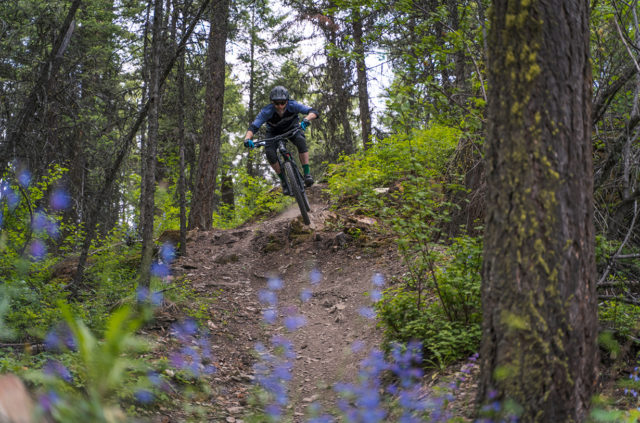
The Trail Pistol’s frame was fairly noticeably stiffer than the Smuggler’s — the Smuggler had some moderately significant flex through corners, whereas the Trail Pistol was tracking a bit straighter. The Smuggler’s flex wasn’t egregious, and I’m not sure I have a clear preference on that issue, but big guys should perhaps take note.
On the descents, the Smuggler clearly did a better job of ironing out mid-sized bumps, which was most of what I was hitting on the trails I rode. The Smuggler was more supple, and maintained better traction through corners where the Trail Pistol was much more likely to get rattled off line. The Trail Pistol handled big hits slightly more gracefully, and it was better at pumping and popping off of rollers. Though, if those rollers were janky and full of roots, sometimes the Smuggler would actually pump better just because it’d stay more composed through the mank. On smoother, flowier trails, I’d likely opt for the more supportive, stiffer chassis of the Trail Pistol. The rougher the trail gets, the more I’d lean towards the Smuggler.
Evil Following
It’s been a while since I owned my Following, and Evil has since updated the bike with the “MB” version. While the Following was notably slack and low when it came out, its geometry has started to look a bit dated these days. The aptness of the comparison between the Following and the Trail Pistol is more based on the Following’s reputation, rather than reality. While the Following still has a very low bottom bracket, compared to a newer bike like the Trail Pistol, the Following is far shorter, with a steeper head angle and a very slack seat tube angle.
The result is that the Following feels smaller and less stable on descents, and you have to work harder to keep the front end down on steep climbs. On steep, rooty climbs, the Following’s suspension is probably a bit more supple, but I’d still take the Trail Pistol due to the better riding position. And the Trail Pistol also wins out in terms of efficiency.
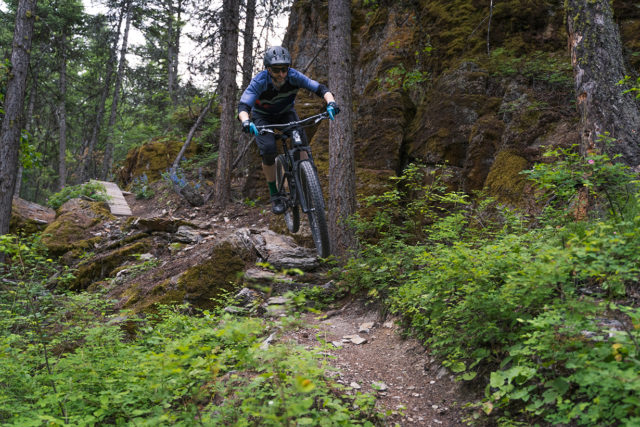
On the way down, the Following’s suspension is definitely more supple, but it’s still an easy bike to load up and pop off of pretty much anything. The Following will clearly iron out the trail a bit better, but the Trail Pistol wins out in terms of pumping and popping. But mostly, its the sizing and geometry that separates these bikes; the Following is just smaller — the XL Following is significantly smaller than the Size 3 Trail Pistol that I rode. That’ll make it feel whippier and easy to move around, but less stable at speed and generally less “chargy.” If you’re more inclined towards slower speeds and sniffing out little side jibs, the Following is great for that. If you’re more inclined towards high-speed destruction, then Trail Pistol.
The new Santa Cruz Tallboy (V4) is also clearly a contender in the category of short-travel bikes that like to get rowdy. Unfortunately, I haven’t yet spent any time on it, so I can’t comment on how it compares.
Bottom Line
I have to admit, I’m pretty excited about what Guerrilla Gravity is doing. While I’m not the guy sporting a “love or leave it” American flag bumper sticker and rolling coal on my lifted dually, I still get excited about made-in-America products. And when a company like Guerrilla Gravity figures out how to make a carbon frame, in Colorado, and manages to sell it for less than the vast majority of carbon frames on the market, well, that’s worth taking note of. And on top of all that, the frame has all kinds of cool ideas incorporated into it that I’d be excited about, even if the thing was built in Taiwan and cost $1,000 more.
Ultimately, it’s the modular frame platform that I think is the biggest selling point for this bike. The ability to turn it into a Smash — Guerrilla Gravity’s 145 mm 29er platform — is pretty significant in my view. Buy a seatstay kit, a rear shock, and an air shaft kit for the fork for around $1,000, and after about an hour of wrenching, you can turn the Trail Pistol into a completely different bike. You get 2 bikes for the price of 1 ¼ bikes — I don’t know of any other bike on the market that can offer that.
But putting all of that neat stuff aside, the Trail Pistol is a very modern, short-travel ripper that clearly favors someone who (1) wants to go fast, (2) is willing to go fast all the time, and (3) favors a more supportive bike that wants to build speed on pumps rather than plowing through chop. I’d love to see Guerrilla Gravity eek a bit more mid-stroke compliance out of the rear end — personally, I think keeping the back end more planted would be worth the cost of reduced supportiveness. But opinions will likely vary on that subject.
The Trail Pistol isn’t a couch, nor is it the bike to go on a meandering weekend cruise with your 6-year-old. But if you’re the kind of person who’s inclined to tee up that big gap on a 120mm-travel bike, then yes, you’re in the right place.
[Update from David Golay, 1/24/2020]
Intro
I’ve now been spending a bunch of time on the Trail Pistol as well, so here I’m updating Noah’s review with my own thoughts and perspectives on the bike. On paper, the Trail Pistol looks like an intriguing blend of short travel and comparatively aggressive geometry, but how does that balance shake out on the trail? I’ve been quite eager to find out, and you can read my thoughts below.
The Details
Noah did a great job of covering the super interesting stuff Guerrilla Gravity has going on with their in-house carbon manufacturing, as well as the design and details of the Trail Pistol frame, so I won’t waste words rehashing all of that. I do want to add that, new for 2020, Guerrilla Gravity is including molded rubber downtube and chainstay / seatstay protectors with all of their full-suspension bikes. Our test bike predates that update, but Guerrilla Gravity says that the new guards can be retrofitted to older Revved frames, so we’ll try to get our hands on a set and will update the review with some thoughts on those if and when we do.
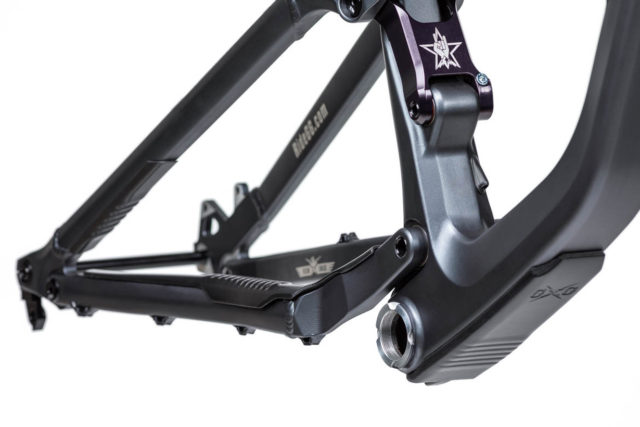
I also want to note that the rear triangle fits together exceptionally well on the Trail Pistol. I’ve had plenty of other bikes – including, frankly, a first-generation Guerrilla Gravity Megatrail – that left a bit to be desired in this area, and required a bunch of shimming and fiddling to get everything to line up perfectly. Particularly given the modular platform of Guerrilla Gravity’s bikes, and that a bunch of people are likely to be swapping chainstays around to change the bike between models, it’s a very good thing that Guerrilla Gravity has the tolerances dialed on those parts.
Geometry and Sizing
I’ve been riding the same Size 3 frame that Noah tested, and at 6’ tall, that’s firmly where the Guerrilla Gravity size selector widget puts me – suggesting a 50 mm stem and the short position for the GeoAdjust if I select “All Around,” or a 50 mm stem and long position if I go with “Full Throttle.” The bike arrived with the 32 mm stem Noah opted for, which, unsurprisingly, felt a bit short for me, and after the first ride I swapped it for a 40 mm Syntace, along with an 800 mm wide Thomson DH bar. I wouldn’t have minded the stock 780 mm Race Face Next, but I didn’t have a 35 mm clamp stem in the 40-ish mm range handy, which lead to the swap for the 31.8 mm items I had going spare. I’ve kept that cockpit setup, with the headset in the long position, for the remainder of my time on the Trail Pistol.
This setup fits me well, and at no point have I been tempted to deviate from the Size 3 or the long headset position. Noah was absolutely correct to note that, though the reach on the Trail Pistol is huge compared to bikes of just a few years ago, when combined with the blessedly steep seat tube angle, the effective top tube isn’t radically long. All of this is very much in keeping with modern trends in mountain bike geometry – which Noah and I spoke in much more length about with Jonathan on our Bikes and Big Ideas episode about the best and most influential mountain bike products of the last decade.
Since Noah’s review was published, Guerrilla Gravity has, unfortunately, put the Size 1 offering on hold. The size configurator recommends a Size 2 down to a 5’4”, “All Around” rider (with a 40mm stem, in the short headset position), but the loss of the Size 1 is a bit limiting for the shorter folks out there.
The Build
Apart from the aforementioned bar and stem swap, I first rode the Trail Pistol in the stock Ride 1 configuration that Noah described, and then also swapped in a Fox DPX2 rear shock, as an upgrade to the RockShox Deluxe Select. Guerrilla Gravity has recently tweaked its build offerings for 2020 – the “Ride 1” build tested here is now referred to as “Rally,” and features some spec changes – and as Noah noted, Guerrilla Gravity’s build configurator gives a very cool degree of customization to swap parts and set things up to your liking. I’ll comment more on the two shocks I’ve run on the Trail Pistol later in the review, but neither is available in the new 2020 build options. The base shock for the Rally build is now a Fox DPS Performance.
One thing that I do want to highlight is that, if you’re intending to take advantage of the modular frame platform and buy a second seatstay tuning kit, it’s worth giving some thought to which bike you order as the original build. If, for example, you want to be able to set the bike up as both a Trail Pistol and a Smash – and, spoiler alert, we’ve done just that, and will have a review of the Smash up once we’ve been able to spend some more time on it – it’d be worth considering which of the fork options can be converted to a travel setting that would be appropriate for both bikes. Guerrilla Gravity can help navigate those sorts of considerations in the ordering process, but it’s something to keep in mind. Noah’s suggestion of a 140 mm Fox 36 on a Trail Pistol is a great one, but it’s no longer an option in the build configurator. On the Smash, however, 150 mm or 170 mm Fix 36s are on offer, and Fox will gladly sell you a 140 mm air shaft for a modest price. See where I’m going with this?
Like Noah, I hadn’t ridden the SDG Tellis dropper before, but it’s been an entirely competent performer in my time on it. I think the greatest compliment that I can pay to a dropper post is to say that I haven’t had to think about it at all, and my time on the Tellis has been seamless. I would swap the 150 mm model for a 170 mm (a $0 upcharge in the build list) but otherwise, I’ve got no complaints.
I received the bike with a (thoroughly worn out — thanks, Noah) 2.3” Minion DHR rear tire in a DoubleDown casing swapped on, and I’m with Noah in thinking that I’d like to see similarly burly tires as an option. Given that there are a number of choices, some of which come for a modest upcharge, in the configurator, why not include something more stout than an Exo casing? That’d be a lot more useful than keeping the Rekons around.
I also like the SRAM GX Eagle drivetrain just fine, but if I were ordering a Rally build, I’d swap in the new Shimano XT 12-speed setup, and actually save $45 by doing so. Both work well, but the XT package feels just a bit smoother and crisper overall, and I like that the XT shifter allows for two upshifts with a single stroke of the paddle. I’m also a fan of the fact that Shimano offers multiple cassette options on their 1x drivetrain. I don’t really need or want a 50+ tooth granny gear, and being able to run a lighter 10-45t cassette with tighter jumps between the gears is nice.
It’s a bummer that the Fox DPX2 shock and 140 mm Fox 36 fork aren’t on offer anymore, because they’d be my suspension picks if they were available. As it is, I’d probably stick with the 130 mm Pike Ultimate and Fox DPS Performance that come on the Rally build.
The Ride
Like Noah, I got on the Trail Pistol hoping to find a bike that struck a balance between having the geometry to hold up to some high-speed charging, while maintaining some of the sprightly feel and pop of a shorter-travel, more compact bike. I think I found that, or at least a version of it, a bit more concretely than Noah did. I’ll explain below.
Climbing
I fully agree with Noah here. For a bunch of reasons – geometry, cockpit layout, weight – the Trail Pistol feels more like an Enduro bike that happens to have a bit less travel and consequently pedals better than it does like a beefed-up XC bike. How you feel about the Trail Pistol on the way up is going to depend on what you’re used to. If, like me, you spend a lot of time on ~6” travel Enduro bikes, the Trail Pistol is going to feel like a significantly quicker, more sprightly version of that. Riders used to an XC race bike are likely to find it a bit ponderous. It’s not a rocketship by the standards of 120mm-travel bikes, but given what I’m going to say about how the Trail Pistol performs on the way back down, I’m not mad about that at all.
I did have one issue with climbing on the Trail Pistol. When I first got on it and started climbing, my calves rubbed on the seatstays with almost every pedal stroke. Noah didn’t have any such issues, so I can only conclude that my calves are amazing, and that he needs to stop skipping leg day.
I’m kidding on that last part. While I did have a lot of very annoying calf rubbing on my first ride, it was making contact by a small enough margin that adding two pedal washers per side was enough to make it almost entirely go away. The TruVativ Descendant Carbon crank on our test bike also has a fairly deep recess on the pedal threads – presumably meant to make room for a pedal washer, which I didn’t have in place on that first ride. I had a couple of my riding partners hop on the bike for a quick test before I added the pedal washers, and none of them noticed any rubbing, either. A little fiddling with my cleat position probably could have made it go away as well. I don’t think most people will have an issue, but it’s worth noting if you’ve had similar problems on other bikes before.
Descending
Noah is absolutely right to describe the Trail Pistol as concretely at the firm-and-supportive end of the spectrum, and I think that makes a ton of sense for a relatively aggressive short-travel bike. A 120 mm bike just doesn’t have enough travel to be a super plush monster truck, no matter how that suspension is tuned. And by making things firm supportive, Guerrilla Gravity has made a bike that can rally very hard, provided that you’re willing to adopt a bit of a more active style, and work with the bike to stay light over obstacles, rather than trying to pulverize them to dust.
While I agree with Noah that the Trail Pistol is far from the most compliant bike out there, I found that its proclivity for seeking out features to pop off, pump through, and otherwise take a dynamic approach to riding made up for that. And though I’d love to call Noah a wimp for the second time in this review and say that he should stop expecting the bike to do all the work for him, I think the actual answer is that a lot of his uncertainty regarding the character of the Trail Pistol just comes down to sizing.
The Size 3 Trail Pistol doesn’t feel like an especially long bike to me, given my height and the bikes that I’m used to riding. As a result, the Trail Pistol is easy for me to throw around, and I found it an absolute blast, provided that I had the energy and wherewithal to work with it and take an active approach to my riding. This isn’t a bike that wants you to sit back and try to point and shoot straight through a big gnarly rock garden, but rather one that rewards a healthy degree of rider precision and a dynamic style. And if it had a significantly longer reach, or I was a bit shorter, I can very readily imagine that I’d struggle to move around on the bike and ride it with the style it demands.
This isn’t a bike that I think everyone could get on and click with right away, but rather one that’s a bit more focused on the sort of rider that it will appeal to. That is in no way a criticism; I’m glad that there are bike companies out there making different bikes that truly feel substantially different from their competition. I’m just saying that, if “plush” is at the top of your list of criteria in looking for a bike, the Trail Pistol might not be your best bet.
Much like Noah’s experience with a Fox DHX2 on the Trail Pistol, I found that the DPX2 made the rear end a bit more composed than it was with the Rock Shox Deluxe, but the shock change (unsurprisingly) didn’t transform the bike into something categorically different. It’s still firm, supportive, poppy, and not especially forgiving, albeit a bit more calm and composed in high-speed chatter. In particular, the rebound circuit on the Deluxe felt not up to the task, and I struggled to find a setting that struck the right balance between not getting bogged down through high-speed chatter, without feeling underdamped and pogo-y.
As with the shock swap, changing between “Plush” and “Crush” modes is more of a subtle tweak than a Dr. Jekyll / Mr. Hyde scenario. In either position, the bike is firm, poppy, and supportive, just to slightly varying degrees. I found myself preferring to just lean into the bike’s character and run it in Crush mode most of the time.
Cornering didn’t present me the same conundrum it did Noah, but again, I think sizing is the main thing at play – I’m simply taller and used to longer bikes. He’s right to say that new-school, slack-head-angle, long-reach bikes do work better with a more neutral approach; stay centered on the bike (the long reach is already pulling you forward), turn the bike with more lean and less handlebar input, and let it do its thing. The Trail Pistol is no different in this regard.
Unlike Noah, I haven’t had an opportunity to ride the Trail Pistol with a 140mm-travel fork, but I’ve got a suspicion that I’d like it better with one. It’s not that 130 mm really feels undergunned, but my hunch is that it’d feel a bit more balanced with a touch slacker headtube angle and a little extra front travel. Either way, 10 mm isn’t a big change, and I am just guessing here.
Bottom Line
Ultimately, my conclusions are awfully similar to Noah’s. The Trail Pistol is a decidedly game-on bike, and is going to work far better under an aggressive rider than it will for a beginner, or someone who’s not interesting taking an active approach to working the bike through more demanding sections of trail. To reiterate what I said in the climbing section, the Trail Pistol feels far more like an Enduro bike with less travel and the geometry tweaked to make it a little more nimble than it does like a beefed-up, short-travel bike – which is unsurprising, given that its platform mates include two actual Enduro bikes. The Trail Pistol is also a comparatively long bike, and one that I’d be careful about sizing up on, given how much it wants to be popped off and pumped through trail features at every opportunity. Get on the right size and approach it with the right mindset though, and the Trail Pistol is excellent.

Thanks Noah. Always enjoy your reviews. Keep ’em coming!
Love my Revved Smash. Suggestion. Try the bike with a Fox DPX2 Shock. And definitely try plush mode.
Yeah, I can see a DPX2 working really well on this bike. And yup, I’ll mess around with the suspension a bunch more and report back in the full review. The Smash looks like a rad bike – I might have to get a seatstay kit to convert the Trail Pistol at some point!
Rock on. Glad you guys are reviewing em. I’m a fanboy and this is my 4th GG bike
I generally have issues with my front tire washing out in soft corners on longer bikes, how is the seated loose cornering stability of this bike? Does it feel like the front wants to naturally wash or is it pretty planteD?
So far, it seems fairly planted, provided I stay centered in a neutral position. My instinct is to get forward, but then I’m kind of fighting the geometry’s natural inclination to put my weight more or less where it should be, and the front tire starts doing weird things. My first couple of rides, this felt weird, but the more time I spend on the bike, the more I’m getting used to just staying neutral and letting the bike do its thing, which works really well. For seated cornering, I only really do that while I’m climbing, and I find the front to be pretty planted – the steep seat tube angle does a really good job of keeping weight on the front wheel.
I’m glad to see you reviewing out-of-the-mainstream bikes. It would be interesting to compare it to the new slacked out Ibis Ripley.
Indeed. Hoping to get my hands on the Ripley a little later this summer.
I’ve been thinking about this bike as a trail/xc rig. How well does it climb?
Hey Noah, thanks for the review. How does it work for seated jumping? My current bike keeps bucking me, is this one any better?
How about seated bunny hopping?
It’s easily in the top 5 best bikes I’ve ever ridden for seated jumping. I’m still working on my seated bunny hops, but hopefully this bike will help me improve.
Bucking is generally a function of shock’s rebound being too fast. It’ll be a balance between getting good pop and low buck for jumps. Most shocks have a low speed rebound adjustment to balance the traction versus chassis stability, but adjustments also affects high speed rebound. If your shock adjustment doesn’t compensate enough for the bucking while maintaining traction, then you may need a revalve of the high speed circuit. The bucking problem can also be exasperated by running the fork rebound slower than the shock.
Glad you are liking the TP. I’ve been riding a GG Smash since 2018 and loving it. My GF has a 2019 Revved Smash on order. Should be here pretty soon and her stoke levels are reaching all time highs! :)
We’ll look for your long term TP review.
Hey Noah, great review! I’ve got about 300 miles on my Trail Pistol so far. Although my bike is set up a little differently from yours (140/130 with a coil), my sentiments are very similar to yours.
One suggestion that I’d make is to try a shorter offset fork on the bike. You’re definitely correct in stating that the Pistol is a damn long trail bike, and that left to its own devices it’s noticeably lacking in the corners. However, switching to a 46mm offset fork was a game-changer for this bike. You get to keep that “big bike” stability at speed, in gnar, and in steep terrain, but the decreased trail number from the short offset really wakes up the cornering and hides the long wheelbase when you need to sneak around the inside of a tight switchback.
Give it a shot.
Great review Noah!
Excited to hear your long term thoughts. My plans of buying a Carbon Patrol may be derailed by the new carbon Megatrail. I’m sure you’re still gathering data, but since they all share the same frame – is there anything negative about the new frame that you noticed? I think it’s cool they incorporated all the adjustability, but makes me wonder if that doesn’t add more opportunities for creaking. Hoping to make this a long term bike, and would love to hear some frame feedback from a fellow Montana rider before I drop 6k.
Cheers!
Definitely looking forward to the long term review. The fact that I can get a top shelf XTR build w/carbon wheels for $1000 less than the other-CO-guys mediocre X01 build is mighty tempting.
I’m not Noah, but I have some thoughts.
I’m several hundred miles into my Revved frame with zero creaking, and I credit this to the fact that everything is on a bearing. Not a bushing to be found. I also had some reservations about the geo-adjust headset getting creaky, but at least right now those have turned out to be unfounded fears. The bike is really quiet, provided you spend a minute putting in quality chainstay protection of some sort.
The only negatives that I’ve found about the frame is 1) the weight and 2) the cable routing. For those people looking at the Trail Pistol, it’s kind of hard to justify 29-30lbs (for most builds) when other bikes in the same class are routinely weighing in around 2 or 3 lbs less (Ripley, SB130, Jeffsy). That said, the Smash weighs the exact same, and for a long travel 29er, that weight is very palatable.
As to the cable routing: when you mess with one cable, you mess all the cables. I haven’t had to mess with mine a lot, but when I have, I’ve found it to be just as much of a headache as standard internal routing, with the added issue that if you don’t get the cables to sit *just* so, you can pinch your derailleur/dropper lines, and they don’t want to work properly.
All things considered, I would call these minor issues. If you’re looking for a burly, aggressive, durable, sexy frame, with a lot of options for customization, you’re definitely in the right place. The bike is SOLID, planted, fast, and ready to party hard. I’m loving my Trail Pistol / Smash, and will likely ride it for the next 2-3 years without being tempted away.
Thanks Zachary!
Just ordered up a custom megatrail. I appreciate your time and the honest feedback!
Cheers,
Travis
How is it now? It’s been a minute
I’m really interested in the “pisotla” offered on GG’s secret menu. 130 rear instead
Ridegg.com/sixsixsix
Yeah, I think the Pistola with a larger volume air shock could be a really fun setup.
Why the dodging around thermoplastic vs. thermoset? I know it’s dry technical, but they’ve discussed it a bit in media. I’m sure there is IP and secret sauce but not all hand-wavy bike frame magic ;)
It was interesting hearing your experience with the Trail Pistol’s long reach and short chain stays. Some of the scions of new school geometry (ie Pole, GeoMetron/Nicholai) extol the virtue of both long reach and long chain stays, explicitly eschewing short rear ends. David’s review of the G16 last month generally seemed to concur with this notion of geometry. Do you have any thoughts on this “controversy”?
As you noted, I’m generally on board with that line of thinking, but an important clarification is that I think that head angle and fork length play a significant role here too. The idea is that as the front center of the bike gets longer, it makes sense to make the chainstays longer to avoid shifting the weight balance excessively rearward. Since the Trail Pistol is a bit on the shorter travel side (i.e. doesn’t use a massively long fork) and doesn’t have a super slack head angle, not going super long on the chainstays makes sense to me.
To be clear, I say that having not ridden one – Noah’s in a much better position to speak to the TP specifically. But that’s my $0.02 on how I think about such things in general.
Sorry! Slow reply on this.
This is a great question, and one that I haven’t come to a definitive conclusion on. For bikes with shorter, more traditional front ends, I tend to be a fan a somewhat longer chainstays. I find the ride to be a bit more balanced, and they corner better, especially in flat, drifty situations. Although that comes at the cost of some playfulness.
But I disagree with David’s take a little bit – as the front end of the bike gets longer, my body leans forward, and therefore my weight is further forward. Thus, the rear end can be shortened a smidge to preserve a more centered weight distribution. Or, at least, the rear end doesn’t necessarily need to be lengthened to gain a relatively centered distribution.
Unfortunately, I haven’t had a chance to ride anything with a long front end paired with a long rear end. The closest I’ve tried is a Mondraker Foxy 29, which has a long reach and middle-ish length chainstays (about 10mm longer than the Trail Pistol, but still fairly short compared to a Pole or Nicholai).
But based on my time on the Trail Pistol, I’d venture a guess that longer stays would push it even more heavily into the straight line / monster truck mentality, and erase any vestige of whippy playfulness that might still be there. Despite the short stays and short stem I had on there, I already found it difficult to loft the front end on the Trail Pistol, and longer stays would do even more to keep both wheels planted on the ground. As far as cornering, I didn’t find the Trail Pistol to feel unbalanced – it’d hold a clean carve through a flat corner pretty nicely without any necessary effort on my part to get weight forward or back (which is something I usually don’t find to be the case with more traditional short front end / short chainstay bikes). If anything, I’d say the weight bias on the Trail Pistol already feels pretty far over the front wheel, so extending the rear wheel out further might make it a bit too loose in corners and create a dramatic oversteer situation.
So, long story short, I’d be interested to try a long front / long rear bike. But as someone who traditionally has preferred longer stays, I got along with the Trail Pistol’s short stays just fine.
Reading your comments about wanting the TP’s rear end to be plusher if it was a bike you were keeping I’d get the shock tuned. I thought my GG Smash rear end with the stock RS Super Deluxe Coil RCT performed well, but I got the damper tuned by Vorsprung and asked for the compression tune to be much lighter. They did just that and the back end is amazing now. Blasting through chunk all day with a smile on my face.
Noah,
Thanks for the great article. I’m really interested in your points on sizing. I’m almost 6’2″ with almost a 6’3″ wingspan and have a size 4 trail pistol on pre-order, but have been considering downsizing because of how big the reach numbers are. I’d describe myself as more of an all mountain rider than full throttle, but I was a bit worried about being cramped on the size 3. Maybe with a bit bigger fork (reduces reach slightly) the size 4 is still the way to go? I’m curious what you’d recommend.
At your size, would you stick with the size 3 for a smash, but still downsize to a 2 for the pistola?
Hey Aaron,
I’m not sure there’s a clear cut answer here. On one hand, I’m 5-6″ shorter than you, and purely in terms of fit, I was comfortable on a size 3, so it seems pretty logical that you’d go with a size 4. On the other hand, like I said in the review, I think sizing down to a size 2 would’ve made the bike feel more playful, which I think I would have preferred.
In terms of GG’s sizing recommendations, you (like me) are right on the line between sizes. So I think it’s reasonable to assume that your conclusion would be similar to mine – you’d be comfortable on a size 4, and that’d be the better option if your trails / riding style is straighter, faster, and plowier. But if you’re more inclined to play around and jib off of side hits, or if your trails are just a bit slower speed and tighter, then going with a size 3 might be the better option; you’d trade some stability for maneuverability.
As far as feeling cramped, I usually only get that feeling when 1) the bike is waaay too small, or 2) if the seat to handlebar distance is too short and my knees are in the way on climbs. I think you’re unlikely to find #1 to be an issue – in either size 3 or 4, the Trail Pistol is still a long bike compared to most other bikes on the market. #2 would potentially be an issue, since the steep seat tube angle means the top tube length isn’t actually all that long. So check the geo chart for your current bike, and check the effective top tube length. See how it compares to the Trail Pistol. If its within 10 or 15 mm, I wouldn’t sweat it – you can tweak the feel of the cockpit while seated pretty easily with stem length and moving the saddle on the rails. But if the size 3 Trail Pistol is more than 15mm shorter in the effective top tube than your current bike, it might feel a bit small (assuming your current bike feels comfortable).
As for the Smash / Pistola – yeah, I think I’d probably stay with a size 3 Smash, but go to a size 2 Pistola. I’ll hopefully be getting a size 3 Smash rolling in the near future, so I’ll report back on that.
Hope that helps!
Noah
Don’t downsize. As Noah says, the cockpit isn’t longer, its just tipped forward, more closely mimicking the “athletic stance.” I’m 5’11” on a size 3 megatrail. While it looks longer, the top tube is the same length, if not shorter than the last 4 bikes I have owned. The sizing recs that GG provides are spot on, unless you have particularly long or short inseam and sleeve length that could throw off those numbers. If you are built proportionally, go size 4, without a doubt.
I find it interesting concerning the comments of a long bike. I just ordered a Trail Pistol in the “Pistola” version which has a similar in geo as the Ibis Ripmo just a bit less travel. Noah, have you ridden the Ripmo?
Why can’t all bike reviews be this thorough. It seems that every other one I read is extremely generic and offers no real insight into the nuances of a particular bike. Great job and thanks for all the info. It has actually helped to make an informed decision.
Great review.
I’ve been looking at getting the “Pistola” frame with a DPX2 to replace my 2017 Hightower. I’m a bit concerned because my local riding is mainly natural singletrack with lots of roots, rocks and brake bumps. So basically medium sized bumps. I enjoy my Hightower on the climbs and slower trails but feel it lacks stability when thins get fast and rough. Have either of you ridden the OG Hightower and can give a comparison? I also recently demoed a SC Bronson and liked that bike a lot when the speed picked up but found it a bit sluggish climbing and putting around.
thanks guys
I have ridden the original Hightower a bit, but it’s been a while, so I want to be careful not to overstate anything here based on some somewhat distant memories of it. That said, I’m confident in saying that the Trail Pistol is substantially more stable, and that the suspension is biased far more towards the firm and supportive end of the spectrum. I think the key thing to think about is how you feel about that balance. Like I tried to make clear in my update to the review, the Trail Pistol is super capable for a 120mm travel bike, but it does require a bit of an active style to get the most out of it. It’s not a great choice if you want to just stand over the bike and have it eat up sections of high speed chatter without you doing anything, but the more you’re willing to pop and pump the bike to iron those out, the more sense it makes.
Agreed with everything David said. I have quite a bit of time on the original Hightower, although, like David, it’s been a couple years. Purely in terms of pedaling efficiency, the Hightower is awesome, and it’s lighter than the TP by a decent amount. But the TP has less travel and a steeper seattube angle, both of which help on climbs, especially as they get steeper. So on the climbs, I’d probably call it a wash. On the descent, like David said, the TP is more stable but also more demanding. Not that the Hightower is a super cushy plow of a bike, but the suspension is more inclined to suck up medium sized bumps. But the TP’s geometry and stability means that, while it won’t iron out those same bumps quite as well, it’s still stable enough that it’ll hold it’s line and carry on with relatively little fuss. Unfortunately I haven’t been on the new Bronson, so I can’t comment there.
-Noah
My recent bike was a Ripmo which was replaced with a Trail Pistola (140/130mm of travel). I feel the Ripmo may climb slightly better on rocky technical type terrain, but the TP is as or more agile, stable and predictable at speed and when descending. The terrain I ride on a regular basis is Lakes Basin. For the TP to perform as good as it does on that terrain by far exceeds my expectations. The comments above about the TP being a long bike are a bit perplexing (its close to or shorter than many bikes including the Ripmo). This may be due to fit, but the bike does not feel sluggish or slow, can pic lines and responds well. I took the chance on the TP and am more than happy with the decision and glad to have supported a product and company that is actually made in America.
Great to hear all the GGTP love. I have a 2018 metal GG Smash and have been thinking about a carbon TP. I’m trying to be kind to my wallet and not buy a new bike in 2020, but sooner or later I’ll be ordering up a TP with a lighter build as companion for the Smash.
Thinking of either shredd Dogg or pistols. Any suggestions?
Great unbiased review! I’m curious how your time on the Smash has been going thus far and how the 2 rear ends compare. My expectation is that it’s far more plush than the TP, but still climbs well enough. Strangely, after a year, there have still been zero longish-term reviews of the Smash.
Thanks! I definitely need more time on the Smash, so I don’t want to say too much yet, but it’s unsurprisingly more plush/less poppy than the Trail Pistol, and does still pedal reasonably well. I’m liking it a lot so far.
Great review with all the right details! I have an alloy 130mm Pistola. The suspension review of the 120mm carbon frame sounds just the same as for the alloy (progression starts a bit too early). It might be worth comparing it to the 130mm set-up and see if this makes it a bit smoother.
Not sure about GGs selection for travel length, the TP seems too burly for a 120mm bike and the Smash is close to an Enduro but then the shock is just a bit short with 145mm. I think a 130mm TP and a 150mm Smash would make more sense.
I’m struggling here with frame Sizemore a TP. I’m same as noah, 5’9” 155, I need to ride full pin full time, but I also like to jump and mess about. My current bike is 450mm with a 50mm stem and feels okay. I just can’t shake the feeling that I could def go longer. But then I feel like I’m just seeking out confirmation bias to get the size 3…. I do plan on going smash/ganarvana with it for bike park, does that tip the scales to a 3? HELP I NEED MY BIAS CONFIRMED ;)